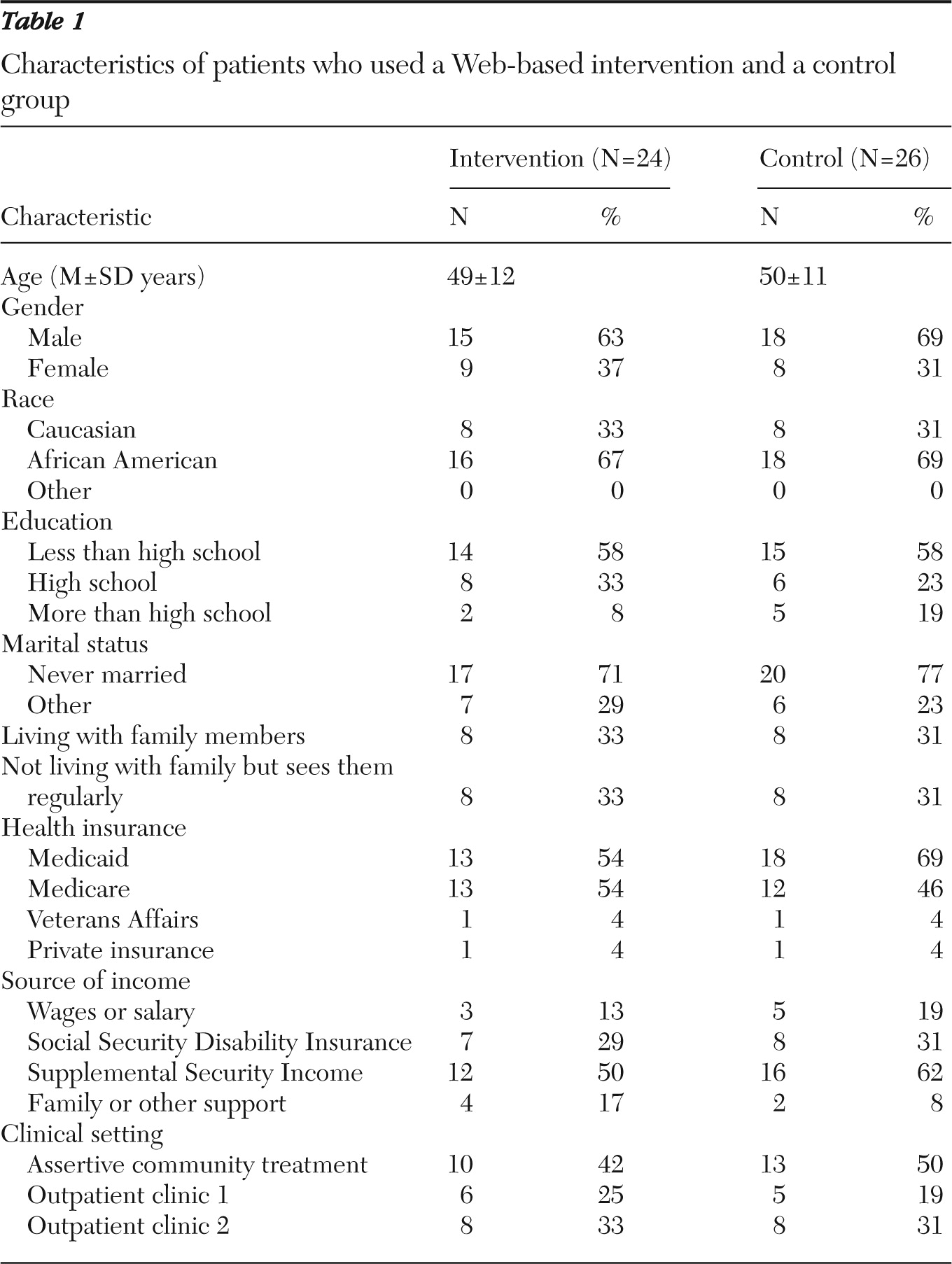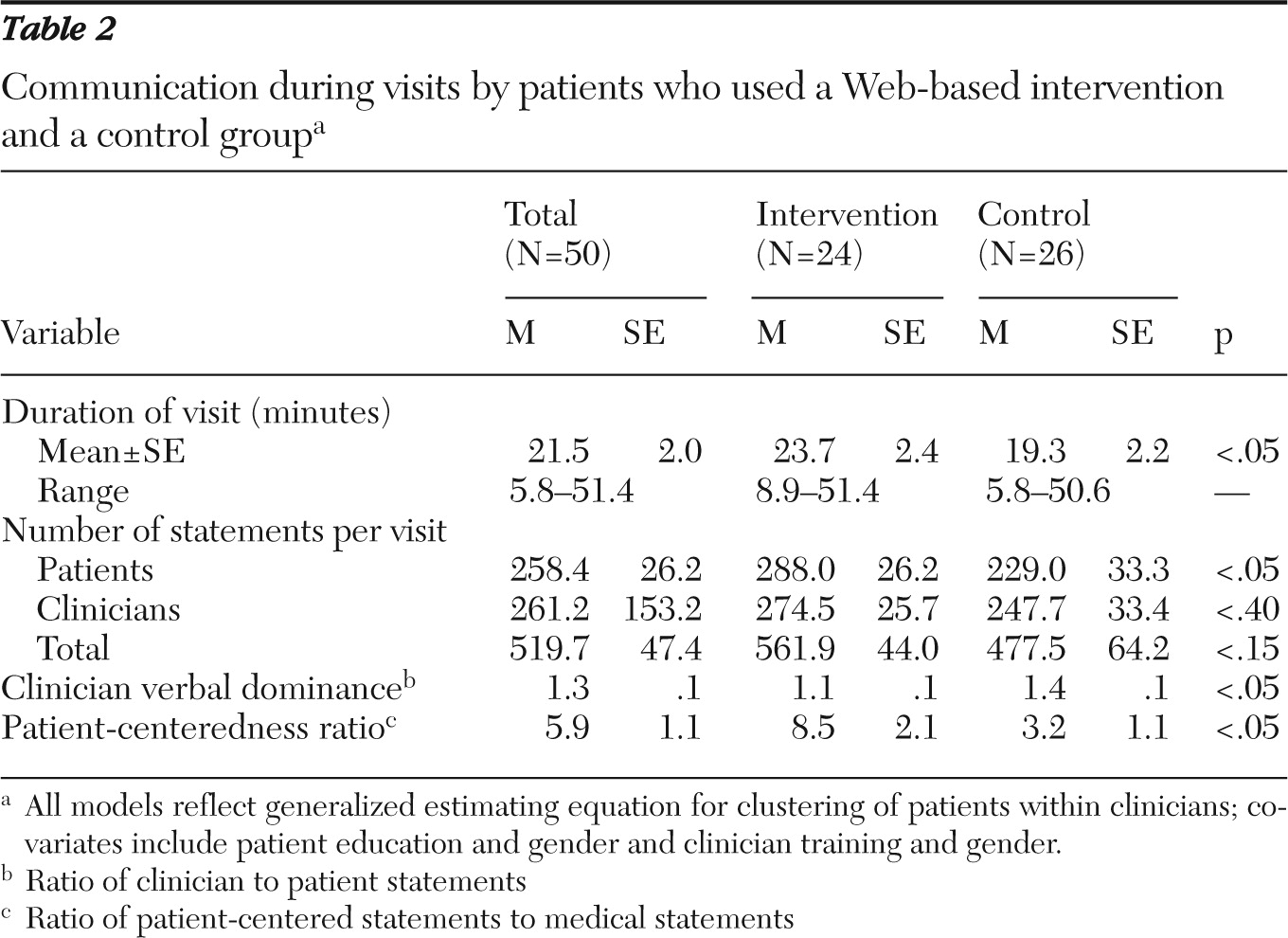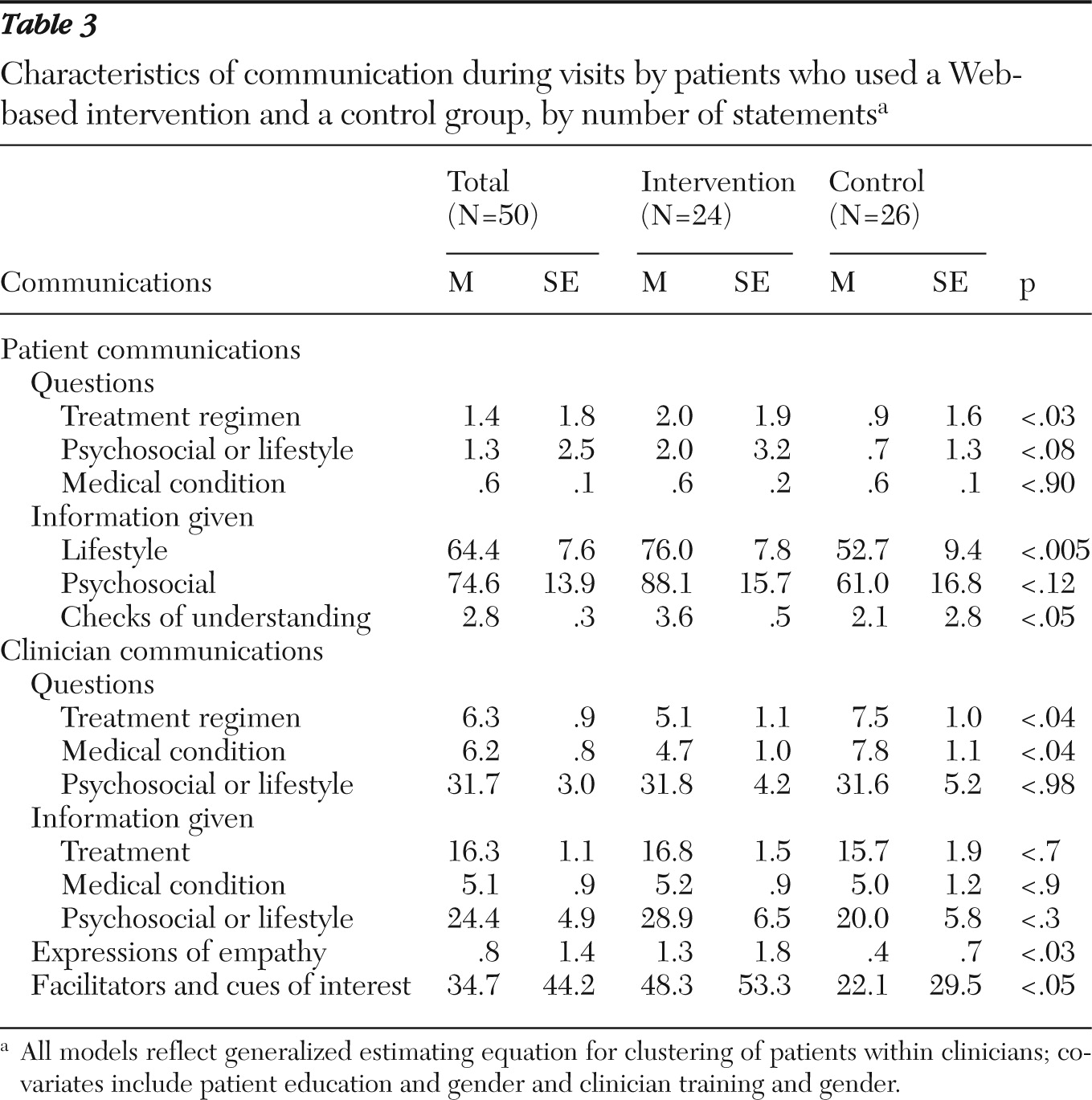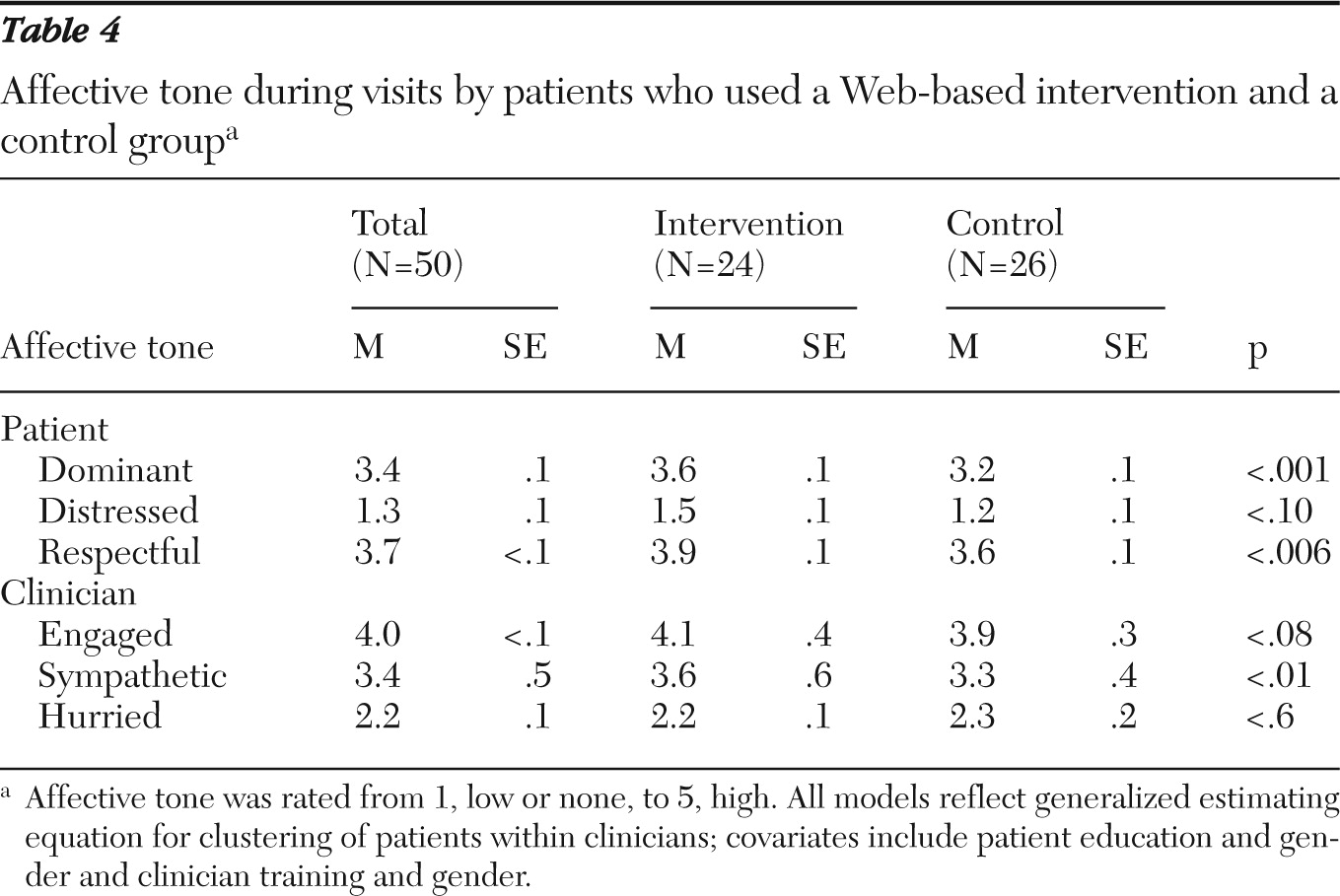Many programs are designed to enhance physicians' communication skills, but less attention has been devoted to helping patients improve their communication during medical visits. Nevertheless, this small body of work has grown substantially since the earliest patient activation interventions were begun some 30 years ago (
1,
2).
In those studies, an intervention conducted in the waiting room to increase patient participation in the medical dialogue was successful in changing patients' communication behavior. A systematic review of patient activation interventions through 2004 identified some 20 studies of this kind, the majority of which reported modest but significant effects, most often in question asking (
3).
None of the activation interventions in the 2004 review took place within the context of mental health care, although it is well documented that psychiatric patients often have expectations and preferences for care but do not readily communicate them to their psychiatrists, who in turn fail to identify what their patients want (
4,
5). In a recent study, Alegráa and colleagues (
6) developed and evaluated an activation and empowerment intervention designed to enhance question-asking skills and self-management strategies for patients receiving care in community mental health clinics. The three-session intervention was successful in increasing patients' self-reported activation during subsequent mental health visits, including greater engagement in information exchange and retention in treatment.
The promising results of that study suggest that psychiatric patients, like others, can benefit from an activation intervention by changing communication during visits to therapists and enhancing their commitment to continued care. However, it appears that no other studies have focused on educating mental health patients about evidence-based treatment, providing feedback, and encouraging discussion with their clinician.
This study furthered this line of work by developing an Internet-based interactive computer tool to educate patients with schizophrenia about evidence-based treatment guidelines and to compare their care to guidelines and receive feedback (
7). The design of the intervention was also motivated by a study that found disparities between the evidence-based treatment recommendations of the Schizophrenia Patient Outcomes Research Team, known as PORT, and the services received by persons with schizophrenia (
8,
9). The study found substantial underuse of psychosocial treatments, including employment and family education interventions, undertreatment of adjunctive depression, and underuse of prophylactic antiparkinson medication. Improving patients' abilities to participate actively in their own treatment and management may lead to increased use of such services.
The goal of the Web-based intervention was to empower patients with schizophrenia to discuss their mental health treatment with their therapist. Patients were randomly assigned to the intervention or to a control group. Subsequently visits to clinicians by each group of patients were audiorecorded and compared by using the Roter Interaction Analysis System (RIAS), which characterizes medical dialogue. The hypotheses were that patients assigned to the intervention would be more verbally active in their visits, particularly in regard to asking questions about drug therapy and side effects and discussing psychosocial and lifestyle issues, and that clinicians' communications with patients who completed the intervention would be more patient-centered than their communications with the other patients.
All patients and clinicians gave signed informed consent to participate. The study was reviewed and approved by the Johns Hopkins Bloomberg School of Public Health Institutional Review Board.
Methods
Study sites and clinician participants
The three study sites were an assertive community treatment (ACT) program and two hospital psychiatric outpatient clinics. A total of 68 clinicians, including psychiatrists, social workers, psychologists, nurses, and counselors, were identified as eligible for the study. Because psychiatrists at the ACT site primarily saw patients for brief medication management visits, only the six nonpsychiatrists at the site were considered eligible. All clinicians at the two psychiatric outpatient clinics, 20 psychiatrists and 42 clinicians from other disciplines, were eligible for recruitment.
Twenty clinicians participated in the study by referring one or more patients with schizophrenia. Participants included five of the 20 (25%) psychiatrists and nine of the 42 (21%) other clinicians at the outpatient clinics and all six nonpsychiatrist clinicians at the ACT site.
Patient participants
Patient eligibility included referral by a study clinician and a scheduled visit during the 18-month study period. Additional criteria were age of 13 or older, a diagnosis of schizophrenia, literacy in English, and ability to give informed consent. A total of 163 eligible patients were identified by research staff through patient lists or records. The refusal rate, either because a clinician declined to refer the patient or the patient directly refused to participate, averaged 55% at the two outpatient clinics and was 30% at the ACT program, resulting in enrollment of 56 patients. Patients were assigned at random to the intervention or a control group.
Web-based intervention
YourSchizophreniaCare is an interactive Web site designed by the research team and programmed first by the Foundation for Accountability and later by HealthGrades, Inc., with CompareYourCare software. YourSchizophreniaCare is a patient-oriented, Web-based learning approach to help patients navigate six areas of quality of care—medications, side effects, referrals, family support, employment, and quality of life. Its goal was to increase the likelihood that patients will initiate discussion of these topics with their therapist. The average time to complete the intervention was 20 minutes.
For each area, patients answer questions about their current status and treatment. On the basis of the pattern of patient responses, individualized feedback recommendations appear on the screen. For instance, patients are asked how often medicine makes them feel restless or jittery inside. If they report medication side effects, they are encouraged to discuss them with their therapist at an upcoming visit.
The feedback is supplemented with video clips of an actor simulating a patient as he or she implements a recommendation for discussing a specific topic with the doctor. The Web site includes 14 unique 30-second video clips designed to model the performance of communication strategies and skills. The clips provide examples of how someone with schizophrenia can broach potentially sensitive issues with a therapist, such as confusion about prescribed drugs, side effects and poor adherence, use of alcohol with medication, barriers to more consistent treatment adherence, and family tensions. Communication strategies to assist the patient to be proactive were also modeled in video clips. They included setting the visit agenda by expressing expectations and goals, using paraphrase and interpretation to check for understanding, asking for plain words instead of scientific terms, and summarizing important information at the close of the visit.
Control group
The control group viewed a 22-minute video about schizophrenia treatment prepared by the Mental Illness Research, Education, and Clinical Center at the U.S. Department of Veterans Affairs Medical Center in Baltimore (
10). They also received a brochure written in lay language that presents five schizophrenia treatment recommendations addressed by the Web-based tool, including maintenance dose of antipsychotic medication, prophylactic antiparkinson medication, antidepressant treatment, family intervention, and supported employment (
7). The combination of brochure and video mirrored the information content of the Web-based intervention but without the personalized feedback or video clips role-modeling discussion of treatment issues provided online.
Analytic approach
The generalized estimating equation method for correlated data was used in all regression analyses in order to account for nonindependence across observations (
11). An exchangeable correlation structure was assumed by using robust estimation, which is likely to yield more accurate or valid coefficient estimates, even if the correlation structure is misspecified (
12). Because some clinicians practiced at more than one site, analyses were not designed to account for intraclass correlation within sites. Covariates included clinician training status (psychiatrist or nonpsychiatrist), clinician gender, patient education level, and patient gender. Other covariates, including race-ethnicity, were not statistically significant in bivariate analyses and were not included in the multivariate model.
Audiorecordings of patient visits were coded with RIAS, a widely used system for characterizing medical dialogue with well-established reliability and predictive validity (
13). Each statement by patient and clinician, defined as a complete thought, is assigned to mutually exclusive and exhaustive codes. Statements are coded directly from recordings without transcription. Several RIAS categories address biomedically focused behaviors, including information giving, question asking, and counseling about general medical and psychiatric symptoms and history and current treatment and regimens, including medication and appointments. Lifestyle and psychosocial categories capture exchange related to the patient's living situation, familial relations, and functions related to daily living or emotional states such as depression or anxiety. Psychosocial exchange also includes any discussion of alcoholism or drug abuse. Socioemotional communication categories for positive or negative exchange and responses to emotion such as empathy, concern, and legitimation are also coded.
Structural indicators of communication include visit duration in minutes, the sum of all patient and clinician statements, and a measure of clinician verbal dominance constructed as the ratio of all clinician statements—excluding such “back channels” as “Go on,” “Yes,” Uh huh, and “Right”—to patient statements. A value greater than 1.0 indicates that the clinician contributed more than the patient to medical dialogue.
In this study, as in other studies that used the RIAS system, patient-centered communication was operationalized as proportionately greater engagement by the patient in information seeking and disclosure in the psychosocial and socioemotional dimensions of illness management than in biomedically focused dialogue about disease management (
14,
15). The patient-centeredness ratio was calculated as the number of patient-centered statements divided by the number of medically focused and directive statements. Specifically, patient-centered statements included patients' psychosocial and medical questions, emotional statements, and information plus the clinicians' psychosocial-related questions, statements providing psychosocial and medical information, statements related to emotional topics, and partnership building statements. Medically focused and directive statements included clinicians' medical questions and statements about procedures and directions and patients' statements providing biomedical information.
Coders also globally rated the emotional tone of the patient and the clinician across several dimensions, such as warmth and sympathy, engagement, friendliness, dominance, hurry, and anxiety, on a scale of 1, low or none, to 5, high. The two coders were not aware of study hypotheses or patients' intervention status. A random sample of five audiotapes was drawn throughout the coding period for double coding to establish intercoder reliability. Pearson correlation coefficients between random pairs of coders were calculated for all categories with an average frequency greater than one. Reliability averaged .88 for provider categories (range .61–.99) and .89 for patient categories (range .81–.99) and was similar to reliability reported by other RIAS studies (
13). For global affect ratings, coders were in 100% agreement within one scale point for provider ratings and averaged 98% agreement within one scale point for patient ratings.
Results
Technical failures in audiorecordings reduced the sample sizes from 56 to 50 patients and from 20 to 19 clinicians. Clinicians included five psychiatrists, five licensed clinical professional counselors, one licensed graduate professional counselor, four licensed graduate social workers, two licensed clinical social workers, a clinical psychologist, a registered nurse with a master's degree in nursing, and another clinician with unspecified training. All the counselors and social workers had master's degrees at minimum; differences in titles reflect Maryland state licensure requirements.
The average number of patients enrolled in the study for each clinician was 2.8 (range one to 12). There were no statistically significant differences in the number of patients in the intervention and control groups seen by psychiatrists or other clinicians. Eleven of the visits by patients in the intervention group were with psychiatrists, five were with clinical counselors, five were with clinical social workers, one was with a clinical psychologist, one was with a registered nurse with a master's degree in nursing, and one was with a clinician with unspecified training. Fifteen of the visits by patients in the control group were with psychiatrists, one was with a clinical counselor, seven were with clinical social workers, two were with clinical psychologists, and one was with a clinician with unspecified training.
Overall, patients were predominantly African American (N=34, 68%), had less than a high school education (N=29, 58%), had an average age of 50, and had never married (N=37, 74%). A total of 16 (32%) were living with family members, 16 (32%) were not living with family but saw them regularly, and 18 (36%) did not see family regularly or had no family in the area. Most patients (N=44, 88%) obtained health insurance coverage through Medicare, Medicaid, or the Department of Veterans Affairs. Fifteen (30%) patients reported receiving Social Security Disability Insurance, and 28 (56%) received Supplemental Security Income. Eight (16%) patients reported some earned income, and six (12%) reported receiving regular contributions from family and other sources. There were no statistically significant differences between intervention and control groups on any of these measures (
Table 1).
As shown in
Table 2, visits by patients in the intervention and control groups differed in a number of ways. Visits by patients in the intervention group were several minutes longer compared with visits by patients in the control group (23.7 versus 19.3 minutes, respectively; p<.05). Patients in the intervention group contributed more actively to the dialogue compared with patients in the control group (288 versus 229 statements per visit; p<.05). The number of statements by clinicians per visit and the total number of statements per visit were higher among visits by the intervention group compared with visits by the control group, but the differences were not statistically significant. Consistent with these dialogue characteristics, the verbal dominance of the clinician was lower in the intervention visits compared with control group visits.
The patient-centeredness ratio was significantly higher during visits by patients in the intervention group compared with visits by patients in the control group (8.5 versus 3.2, p<.05), as shown in
Table 2. A higher patient-centeredness ratio indicates that the visit featured a relatively greater emphasis on psychosocial and lifestyle categories in contrast to biomedical exchange.
More specifically, patients in the intervention group asked more questions about their treatment regimen and tended to discuss psychosocial issues more often than control group patients. They also gave more information about their lifestyles to the therapist and were more likely to check their understanding of information communicated to them (
Table 3). There were no differences between the groups in the number of socioemotional statements, such as expressions of concern, optimism, agreement, or disagreements (data not shown).
During visits with patients in the intervention group, clinicians were significantly less likely to ask questions about the treatment regimen or medical symptoms but were more likely to express empathy and to use more facilitators and cues of interest to encourage the patient to continue to speak (
Table 3). There were no differences between visits by the two groups of patients in other categories of clinician socioemotional or biomedical exchange (data not shown).
Emotional tone of the dialogue differed for both patients and clinicians depending on the study group (
Table 4). Patients in the intervention group were rated as more dominant and respectful than those in the control group. They were also rated as sounding more distressed, but the trend did not reach statistical significance. During visits with patients in the intervention group, clinicians were rated as sounding more sympathetic and warm than during visits with the control group; they were also rated as sounding more engaged in dialogue with intervention group patients, but the trend was not statistically significant.
Discussion
The patient activation intervention was successful in achieving its primary goals. As hypothesized, patients exposed to the intervention were more verbally active during mental health visits than control group patients. Visits with intervention group patients were longer by several minutes, and patients in that group contributed proportionately more to the medical dialogue than control patients. As a result, clinicians were less verbally dominant during visits with patients exposed to the Web site.
In addition, differences between groups in several specific elements of communication were evident. Patients enrolled in the intervention asked more questions about their therapeutic regimen and psychosocial and lifestyle issues and gave more information to the clinician about lifestyle issues. They also were more likely to check that they understood what the clinician said by restating or paraphrasing information to confirm a shared understanding of the facts or of the issues being discussed. In addition, patients in the intervention group were rated as sounding more dominant and respectful in their communication but also as more distressed.
In a somewhat parallel manner, clinician communication also showed intervention effects. During visits with patients in the intervention group, clinicians encouraged patient disclosure by higher use of facilitators and cues of interest and responded more empathically. They also asked fewer questions about the treatment regimen and mental disorder symptoms than during visits with control group patients. This pattern suggested that clinicians allowed patients to steer the dialogue to topics and issues initiated by the patient and gave patients enough time to hear them out. This interpretation is in keeping with the affective ratings, which indicated that during visits with patients in the intervention, clinicians sounded more engaged and sympathetic and no more hurried than during visits with control group patients, even though the visits were longer.
Beyond differences in specific categories of talk, the medical dialogue of visits involving a patient from the intervention group was characterized as significantly more patient centered than visits involving control group patients. Although patient-centered communication may be defined in multiple ways, there is broad consensus affirming its value as a conceptual marker of high-quality care and professionalism (
16,
17).
The relevance of patient centeredness to mental health care may be especially critical in fostering a therapeutic alliance. As noted by several investigators, patient centeredness and therapeutic alliance share conceptual ground (
18,
19). As reported by Wissow and colleagues (
19), there is a significant and positive relationship between the RIAS-based patient-centeredness measure and therapeutic alliance as measured by the Vanderbilt Therapeutic Alliance Scale. This suggests that the activation intervention not only enhanced communication generally but may have created a milieu that fostered a strong affective bond and agreement on goals and processes of treatment.
The study's significant limitations included its small sample and limited generalizability. Fewer than one-third of clinicians at the study sites participated by referring at least one patient, a finding that suggests there was a sizable self-selection bias. Consequently the results were likely to represent clinicians and patients who were most interested in communication and patient activation. As in all observational studies, the presence of a device to record conversation may have influenced communication by inspiring best or most conscientious practice. It is unlikely, however, that best practice was systematically interpreted by therapists in a way that would jeopardize the validity of findings. The issue of performance bias in response to tape recording has been addressed by several studies (
20–
22). All have found that the effect is minimal.
Patients were the unit of randomization, and so providers conducted visits with patients in both the intervention and the control groups, and no attempt was made to blind clinicians to the patient's group. Despite the advantages and strengths of this design, it is possible that some providers may have diminished group differences through a form of compensatory communication with control group patients. For instance, providers may have attempted to elicit greater engagement in the dialogue by asking these patients more questions than they asked intervention patients.
Conclusions
Our findings affirm the potential utility and acceptability of a patient activation intervention designed to improve communication about treatment during visits with clinicians in community mental health settings. Web-based interactive tools can be made widely available and used in clinics and other settings. Patient feedback grounded in evidence-based treatment recommendations for schizophrenia encourages patients to discuss treatment concerns, questions, and options with their therapist. The feedback provides patients with information tailored to their current needs and symptoms. It allows them to discuss potential evidence-based treatment options to resolve current symptoms or seek future outcomes they value, for example, employment.
Acknowledgments and disclosures
This research was supported by grant MH067189 from the National Institute of Mental Health.
Dr. Roter is the author of RIAS and holds the copyright for the system. Johns Hopkins University (JHU) also has rights to enhancements of the system. Neither Dr. Roter nor JHU collects royalties for use of the system in research conducted at the university or its medical institutions. Dr. Roter is a coowner of RIASWorks LLC, a company that provides coding services. The other authors report no competing interests.





